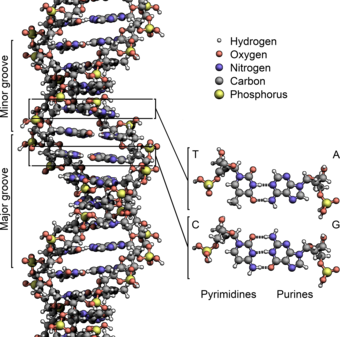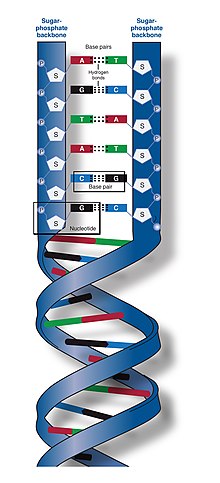
Back DNS Afrikaans Desoxyribonukleinsäure ALS ዲ ኤን ኤ Amharic Acido desoxirribonucleico AN حمض نووي ريبوزي منقوص الأكسجين Arabic حمض نووى ARZ ডি এন এ Assamese Ácidu desoxirribonucleico AST DNT Azerbaijani دیانائی AZB


| Part of a series on |
| Genetics |
|---|
 |
Deoxyribonucleic acid (/diːˈɒksɪˌraɪboʊnjuːˌkliːɪk, -ˌkleɪ-/ ;[1] DNA) is a polymer composed of two strands that coil around each other to form a double helix. The polymer carries genetic instructions for the development, functioning, growth and reproduction of all known organisms and many viruses. Nucleic acids - DNA and RNA (ribonucleic acid) - are one of the four major types of macromolecules that are essential for all known forms of life, alongside proteins, lipids and complex carbohydrates (polysaccharides),
The two DNA strands are known as polynucleotides as they are composed of simpler monomeric units called nucleotides.[2][3] Each nucleotide is composed of three parts: one of four nitrogen-containing nucleobases (cytosine [C], guanine [G], adenine [A] or thymine [T]), a sugar called deoxyribose, and a phosphate group. Attached to each sugar thre is one of these four types of bases. The nucleotides are joined to one another in a chain by covalent bonds (known as the phosphodiester linkage) between the sugar of one nucleotide and the phosphate of the next, resulting in an alternating sugar-phosphate backbone. The nitrogenous bases of the two separate polynucleotide strands are bound together, according to base pairing rules (A with T and C with G), with hydrogen bonds to make double-stranded DNA. The complementary bases are divided into two groups, the single-ringed pyrimidines (T and C) and the double-ringed purines (A and G).
Both strands of double-stranded DNA store the same biological information. This information is replicated when the two strands separate. A large part of DNA (more than 98% for humans) is non-coding, meaning that these sections do not serve as patterns for protein sequences syhtnesis. The two strands of DNA run in opposite directions to each other and are thus antiparallel. Genetic information is encoded by the sequence of these four nucleobases along the backbone. Usually, RNA strands are created using DNA strands as a template in a process called transcription, where DNA bases are exchanged for their complementary bases. An exception in this process is that RNA uses uracil (U) as the complementary for adenine (A), not thymine (T).[4] Based on the genetic code, these RNA strands specify the sequence of amino acids that will form proteins in a process called translation.
In prokaryotes cells (bacteria and archaea), DNA is stored only in the cytoplasm, in circular chromosomes. Within eukaryotic cells, DNA is compacted into bigger structures called chromosomes. This organization happens with the help of chromatin proteins (such as histones). These compacting structures guide the interactions between DNA and other proteins, helping control which parts of the DNA are transcribed. Before typical cell division (mitosis), these chromosomes are duplicated in the process of DNA replication, providing a complete set of chromosomes for each daughter cell. Eukaryotic organisms (animals, plants, fungi and protists) store most of their DNA inside the cell nucleus as nuclear DNA, and some in the mitochondria as mitochondrial DNA or in chloroplasts as chloroplast DNA.[5]
- ^ "deoxyribonucleic acid". Merriam-Webster.com Dictionary.
- ^ Alberts B, Johnson A, Lewis J, Raff M, Roberts K, Walter P (2014). Molecular Biology of the Cell (6th ed.). Garland. p. Chapter 4: DNA, Chromosomes and Genomes. ISBN 978-0-8153-4432-2. Archived from the original on 14 July 2014.
- ^ Purcell A. "DNA". Basic Biology. Archived from the original on 5 January 2017.
- ^ "Uracil". Genome.gov. Retrieved 21 November 2019.
- ^ Russell P (2001). iGenetics. New York: Benjamin Cummings. ISBN 0-8053-4553-1.
© MMXXIII Rich X Search. We shall prevail. All rights reserved. Rich X Search
